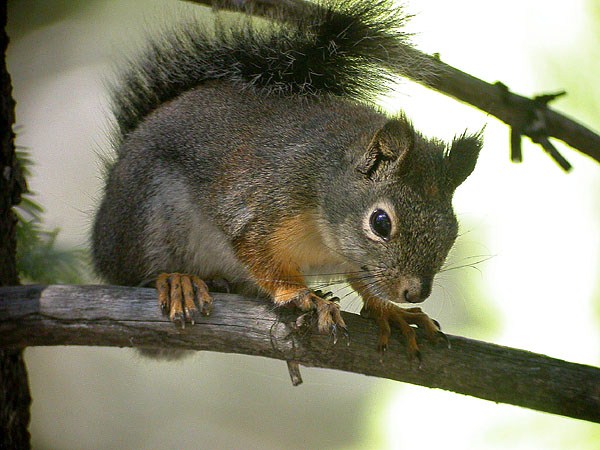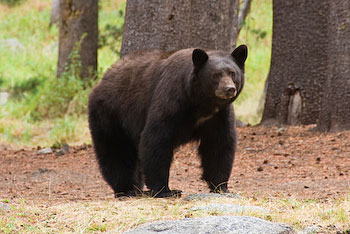Mammals
Of the approximately 90 mammals species in Yosemite, visitors are most likely to  see mule deer and Douglas tree squirrels. Black bears are seen infrequently, and mountain lion sightings are extremely rare due to their shy and secretive nature. In certain locations at elevations above 3,000 meters (about 10,000 feet), lucky visitors might spot the Sierra Nevada bighorn sheep (Ovis canadensis sierrae). The bighorn is a master of heights, racing along precarious ledges and steep cliffs with grace and confidence. The species became the
see mule deer and Douglas tree squirrels. Black bears are seen infrequently, and mountain lion sightings are extremely rare due to their shy and secretive nature. In certain locations at elevations above 3,000 meters (about 10,000 feet), lucky visitors might spot the Sierra Nevada bighorn sheep (Ovis canadensis sierrae). The bighorn is a master of heights, racing along precarious ledges and steep cliffs with grace and confidence. The species became the  only federally endagered mammal in Yosemite in 2000 after numbers dropped to about 125 bighorns in the entire Sierra Nevada. Declines began in the 1850s when gold miners hunted them for food, and deaths escalated when sheep herders brought in domestic sheep. The sheep carried diseases that they had, over time, adapted to resist; however, the bighorns had never been exposed before. Lacking resistance, bighorn herds that came in contact with domestic sheep contracted the diseases and were wiped out. To boost the dwindling populations, bighorn herds were introduced to the Sierra Nevada in the 1890s. Recovery has been slow, with the current count at about 400 individuals. To learn more about recovery
only federally endagered mammal in Yosemite in 2000 after numbers dropped to about 125 bighorns in the entire Sierra Nevada. Declines began in the 1850s when gold miners hunted them for food, and deaths escalated when sheep herders brought in domestic sheep. The sheep carried diseases that they had, over time, adapted to resist; however, the bighorns had never been exposed before. Lacking resistance, bighorn herds that came in contact with domestic sheep contracted the diseases and were wiped out. To boost the dwindling populations, bighorn herds were introduced to the Sierra Nevada in the 1890s. Recovery has been slow, with the current count at about 400 individuals. To learn more about recovery  efforts for the bighorn sheep, visit the Yosemite NP Bighorn Sheep website. https://www.nps.gov/yose/learn/nature/sheep.htm
efforts for the bighorn sheep, visit the Yosemite NP Bighorn Sheep website. https://www.nps.gov/yose/learn/nature/sheep.htm
More Information:
National Park Service- Mammal Checklist: http://www.nps.gov/yose/learn/nature/mammal-species-list.htm
National Park Service- Sierra Nevada Bighorn Sheep: http://www.nps.gov/yose/learn/nature/sheep.htm
National Park Service- Threatened Mammals: http://www.nps.gov/yose/learn/nature/threatened-mammals.htm



